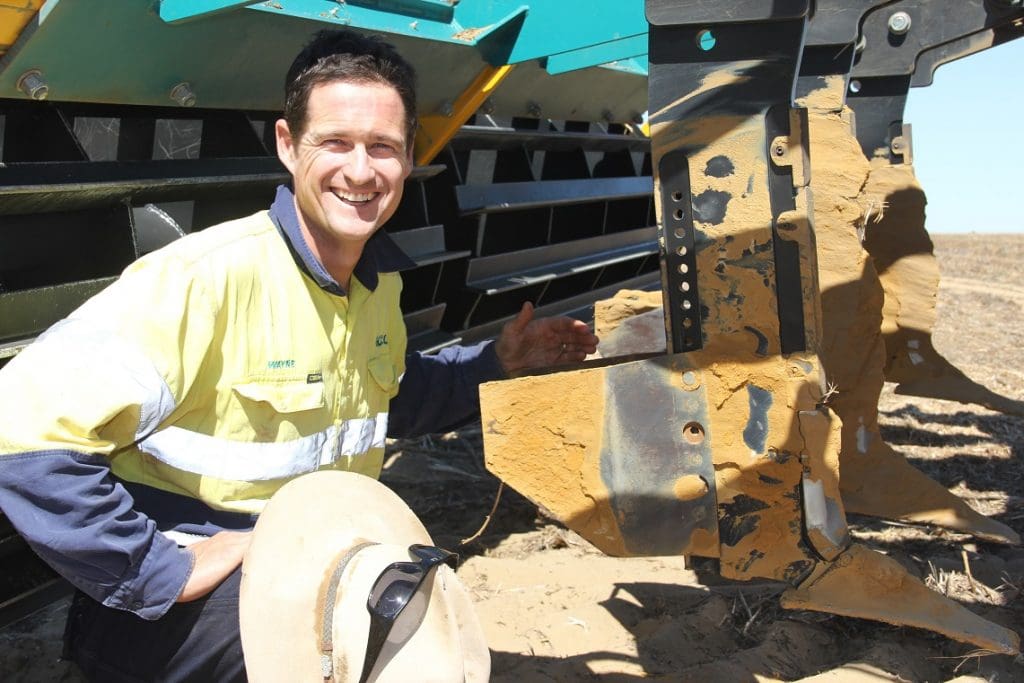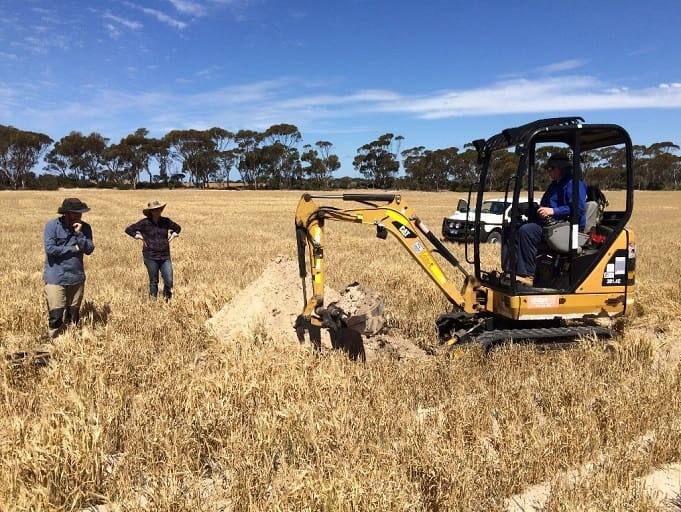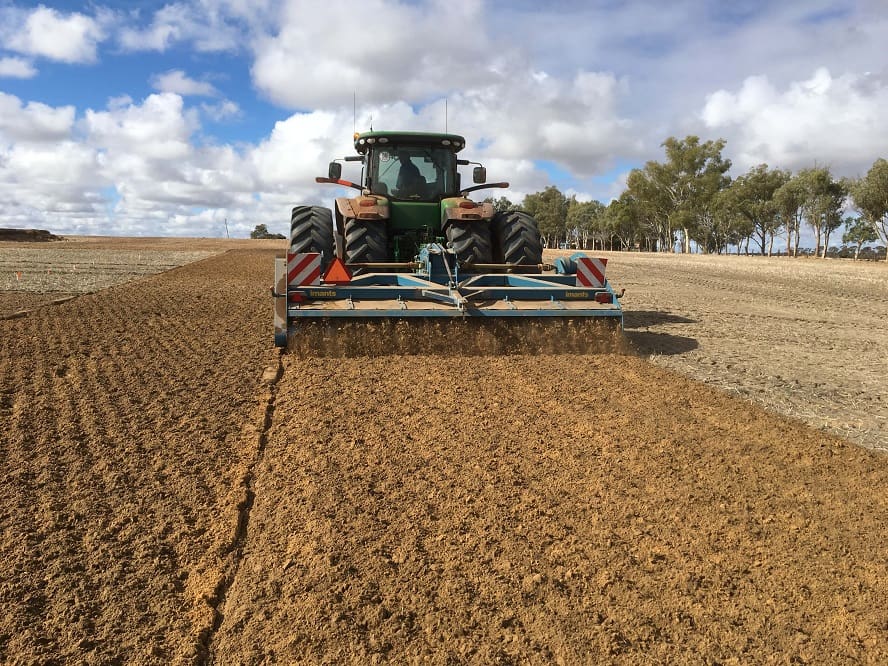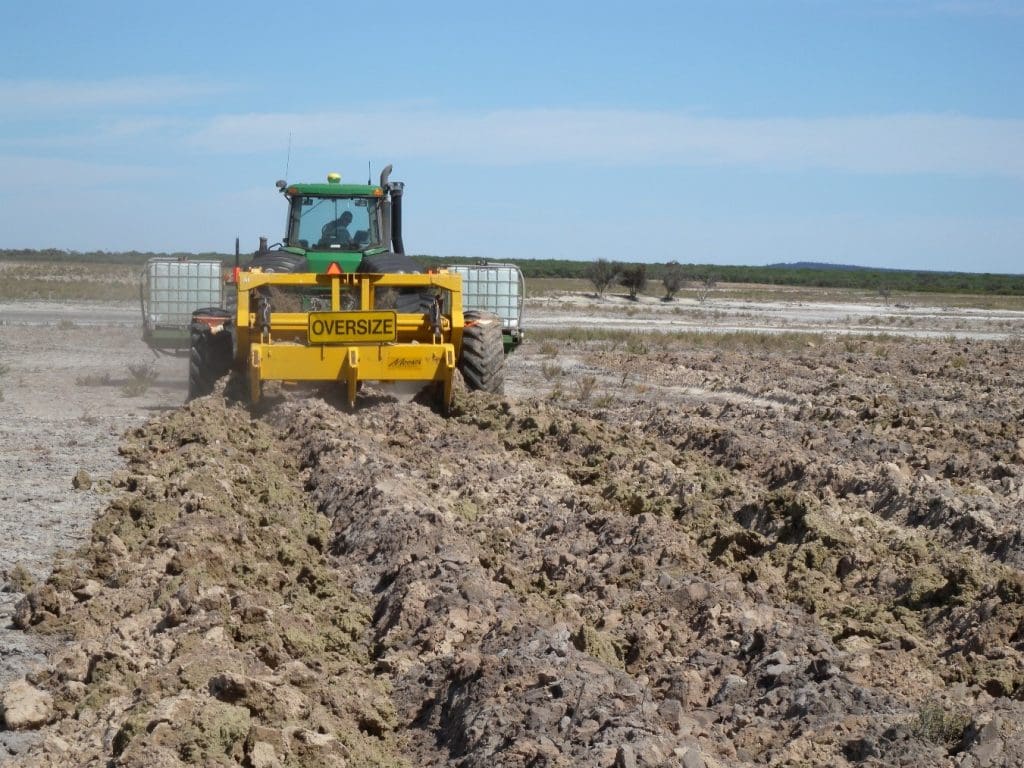
DPIRD research scientist Wayne Parker says ripping deeper than 400mm produced a positive yield response in sand, loamy earth and gritty grey clay soil.
WESTERN Australian trials of deep ripping to greater than 450 millimetres have revealed a potential cumulative return on investment of $1 to $29 per hectare over four years by reducing soil strength.
The five-year project undertaken by the Department of Primary Industries and Regional Development (DPIRD), with Grains Research and Development Corporation (GRDC) co-investment, looked at eight different soil types, at six sites around the State.
Presenting the findings at the GRDC Grains Research Update in Perth, DPIRD research scientist Wayne Parker said the project assessed the economic return from deep ripping to a greater depth and through the use of topsoil slotting plates.
“We found that ripping deeper than 400mm produced a positive yield response in sand, loamy earth and gritty grey clay soil,” he said.
“However, the trials found no benefit from deep ripping in a sodic, calcareous loamy earth, commonly known as a Morrel soil.”
Mr Parker said ripping sandy soils to depths of 300 to 350mm had been common farming practice since deep ripping was first introduced more than 30 years ago.
“Ripping sandy soils to these depths no longer produces the results farmers need,” he said.
“Compaction below 300mm still impacts root growth, which reduces the ability of plants to access moisture and withstand stress.
“Current thinking is that ripping deeper is better, though growers need to understand their depth of compaction to guide their ripping depth and maximise investment.
“Further investigation of variables in deeper ripping programs is still required to maximise returns and improve decisions around crop choice, crop establishment and fertiliser requirements.”
Pale deep sand improvements
Past field trials have demonstrated that topsoil water repellence can be effectively ameliorated on pale deep sands by spreading and mixing clay through the top 300mm with a rotary spader.
However, pale deep sands face additional subsoil constraints including compaction and low cation exchange capacity, which prevent crops from reaching their full potential.
DPIRD scientist Tom Edwards told the Update that research investigating these constraints sought to determine if crop production could be further improved on pale deep sands which had been ameliorated.
“The aim was to improve root growth and the plants’ subsequent abilities to forage for water and nutrients later in the season,” Mr Edwards said.
“We found significant yield improvements were possible when clayed and spaded treatments were ripped to about 40cm to reduce subsoil strength and increase root penetration.
“This highlighted the need to continue to monitor soil strength and water use efficiency after amelioration as re-compaction can occur through the use of farm machinery and cultivation processes, as well as naturally as the subsoil wets and dries.”
The trial also tested the ability and benefits of introducing organic amendments and fertiliser to a 60cm soil depth using a chain trencher.
The process effectively incorporated amendments into the subsoil and improved root abundance, but benefits were only observed within the trenches that had been created and the implement failed to break out and reduce soil strength in between these.
Ripping with inclusion plates did reduce soil strength between tines and was also able to adequately incorporate chicken manure and fertiliser deep into the profile.
“Having these sources of nutrition in the subsoil improved root abundance at depth and significantly increased yield above that measured when the same amendments were left on the surface,” Mr Edwards said.
“The inclusion of the fertiliser increased yield by 750 kilograms per hectare for the 2019 season, which was a significant improvement above ripping and applying the same rate of fertiliser to the surface.”

DPIRD research scientist Tom Edwards and technical officers Rachelle Desmond and Joel Kidd dig soil profiles for assessment of root abundance.
Delay amelioration until soil is moist
DPIRD research scientist Stephen Davies said there were numerous agronomic, operational and erosion-reduction benefits to be gained from delaying soil amelioration until the soil was moist.
Below average growing season rainfall throughout the grainbelt last year and ongoing dry conditions have led to a lack of ground cover, elevating the risk of losing valuable topsoil from wind and water erosion from soil disturbance.
Dr Davies said delaying soil amelioration until the soil was moist would both reduce the erosion risk and create several opportunities.
“Tillage equipment works more effectively in moist soil, particularly subsoils,” he said.
“Sands, in particular, are more cohesive enabling the soil to be carried on the spades of a spader to achieve effective mixing or to ‘hold and fold’ on discs and plough boards for inversion.
“Implements operating in moist soil are able to work deeper and operate more efficiently at optimum depth.”
Reduced resistance from working in moist soil also uses less horsepower and puts less strain and wear on tillage equipment and tractors, saving fuel and maintenance costs and generating efficiencies.
Dr Davies said there were also agronomic advantages to undertaking amelioration in moist soil.
“When water repellent soil is disturbed in dry conditions, the expression of topsoil water repellence increases dramatically,” he said.
“While deep mixing and soil inversion can reduce topsoil water repellence, using tillage implements when the soil is dry is often less effective than amelioration undertaken when the soil is moist.
“Waiting until significant rain falls also provides the opportunity to combine non-chemical weed control through tillage, improving the long-term sustainability of the cropping system.
“Sowing a cereal crop immediately after the soil has been ameliorated when the soil is wet can aid rapid crop emergence and provide an opportunity for the seedlings to grow roots into loose, moist soil.”
Another strategy is to delay soil amelioration until spring, as part of a fallow or ‘renovation year’ to prepare paddocks to aid future management and profitability.
“This may involve spreading amendments, weed knockdown followed by deep tillage in spring and sowing a cereal cover or – in some environments – a summer crop,” Dr Davies said.
“The renovation year can be a useful weed and disease break and with the stubble residue from a late summer or cover crop there is then opportunity to grow a high value break crop the subsequent season.”
While delaying soil amelioration may involve some cost and curtail short-term returns, Dr Davies said it was often worth the compromise in the longer term.
“There are many crop performance benefits to be achieved from delaying soil amelioration, alongside the management advantages to be gained from operating a more sustainable farming system,” he said.
With ongoing dry conditions in many parts of the WA grainbelt, coupled with sparse stubble cover, sandy soils are already at risk of erosion and soil amelioration undertaken when the soil is dry would increase the risk.

There are several production and land management benefits to be gained from delaying soil amelioration works until the soil is moist, including mitigating the risk of soil erosion as a result of dry seasonal conditions.
Avoid amelioration ‘bloopers’
DPIRD research scientist Bindi Isbister told the Update that while yield increases could be achieved through soil amelioration practices, grower case studies and field trials had identified situations where soil amelioration could negatively affect productivity.
Ms Isbister said while yield increases resulting from amelioration could be large, penalties such as poor plant establishment could also result if not done correctly.
“Amelioration ‘bloopers’ include bringing acidic subsoil to the surface from mouldboard ploughing, cloddy soil surface following deep ripping heavy soils or mould ploughing shallow duplex soils, and exposing loose topsoil with the potential for erosion after spading sandy soils,” she said.
“These are particularly prevalent when applying treatments which are inappropriate for targeted constraints or where there is large spatial soil variability.
“This is a common scenario in southern regions of the state, where depths of duplex soil often alternate considerably within individual paddocks.”
Ms Isbister said the key to avoiding mistakes was for farmers to understand the properties of soil to depths below 10cm, as well as spatial variation of soil types across paddocks.
“While the research found that not all soil amelioration bloopers result in long-lasting penalties, better diagnostics are required for duplex soils which can be highly variable over distances of about 10 to 100m,” she said.
“For most growers, time spent upfront on testing for properties such as pH, salinity, particle size, compaction and levels of various chemical elements at depth will save time spent on addressing negative amelioration impacts at a later date.”

Sources: GRDC, DPIRD
Grain Central: Get our free daily cropping news straight to your inbox – Click here

It is true we were deep ripping to at least 300mm on the Erradu sandplain (Geraldton region) way back in the 80s. Ron Jarvis (DofA) did some trials and the results were published in I think 86. Concern at the time was to protect organic matter and so we direct drilled (No till for you young people) because the sands were, probably still are, highly mobile. Any results from the recent trials on ripping and ploughing and the effect on organic matter and soil stability? We found any cultivation was deleterious.